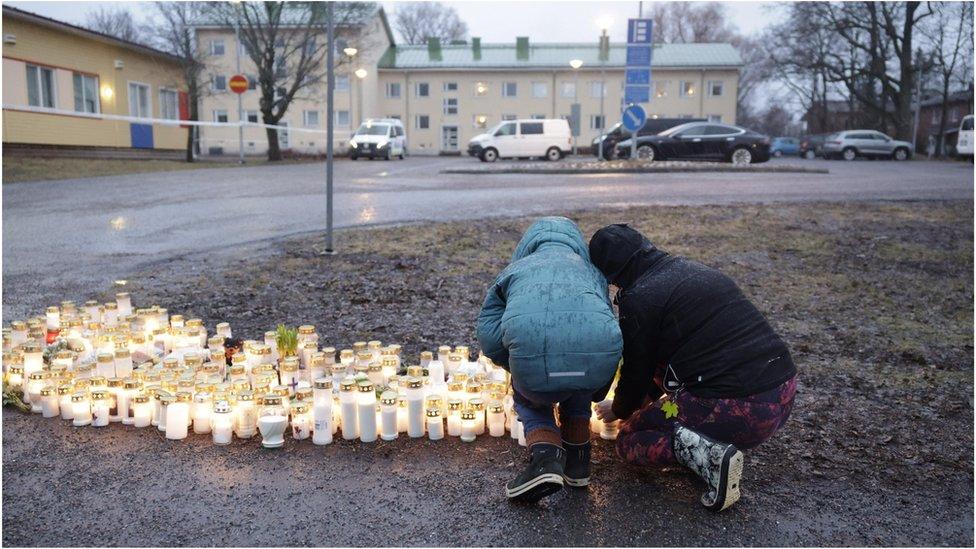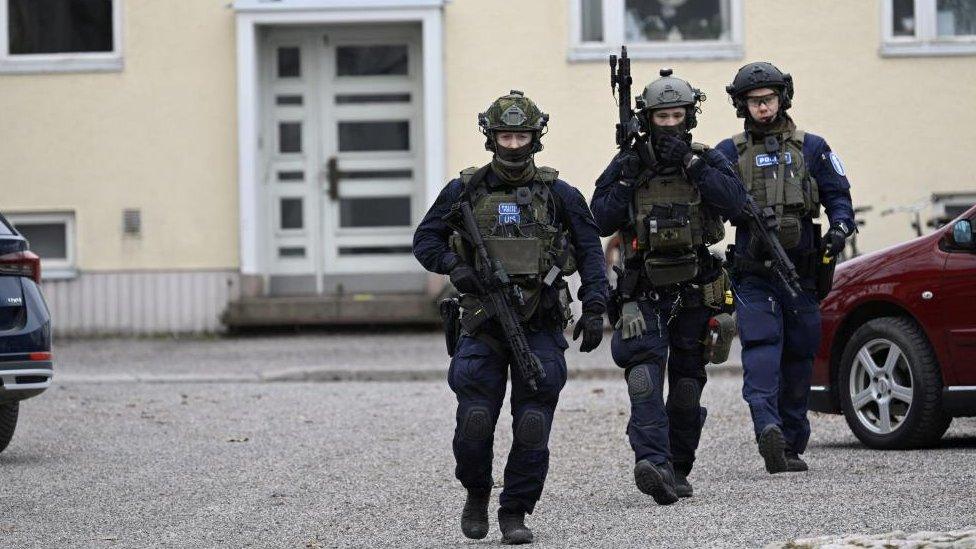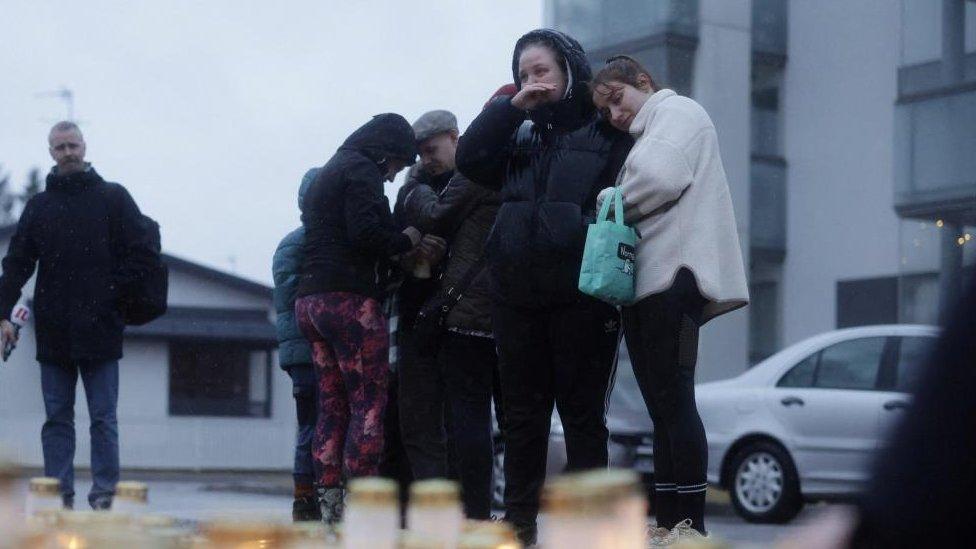School shooting brings up tough questions for Finland
- Published

One child was killed and two were seriously injured in the shooting at the school in Vantaa
In the aftermath of the shooting that saw a 12-year-old kill another child and injure two in the city of Vantaa, north of the capital Helsinki, the headlines in Finland have been full of soul-searching.
"What kind of events led to such an extreme act?"
"How could a 12-year-old get hold of a gun?"
"Could the incident have been prevented somehow?"
Few of these questions have had answers so far.
Instead, harrowing details about the events in Vantaa have continued to emerge.
The boy wore a mask and noise-cancelling headphones, showing his actions were premeditated. He shot his victims on a school premises they all knew well and spent time in every day. The two girls he wounded are still in a serious condition in hospital.
Most shocking of all, the killer was 12 years old.
There have been other school shootings in Finland, although not many: this was only the fourth in the country's history.
"In this case the shooter and the victims are really too young," Tomi Kiilakoski, youth researcher at the University of Tampere, told the BBC. "We are really talking about children - and that shocks us."
Squaring up the brutality of the crime with the young age of the suspect was difficult, he said, and the incident came as "a big shock for children, for the community, for young people and for the whole of Finnish society".
Police revealed on Wednesday that the suspect had indicated the motive behind the shooting was that he had been bullied, and their initial inquiry had confirmed that.
This is likely to worry many Finnish parents. Bullying is very difficult to eradicate, and relatively widespread: studies show that 8.6% of children between the ages of 10-11 in Finland are bullied every week.
Of course, victims of bullying rarely end up killing others, but bullying often features as one of the reasons for extreme acts of violence.
After two school shootings in 2007 and 2008 left 18 dead, a police inspector said that a "system of pre-emptive measures" had been built in that allowed police to intervene if they received information on a "person's intent to stage an attack".
On Tuesday, Finland's National Police Commissioner Seppo Kolehmainen had to admit that system had failed.
Henri Rikander, associate professor of police law at the University of Eastern Finland, told the BBC that out of the 60-100 potential mass shootings Finnish police investigate each year, about 20 are typically in the last stages of preparation and can be classified as "serious".
In the Vantaa case, the boy does not appear to have talked about his plans with anybody - and so may have fallen through the cracks.
That has left Finns wondering how to prevent such a tragedy from happening again.
As it stands, the Vantaa suspect will not face charges and has been placed in the care of social services - so some sections of Finnish society are calling for the age of criminal responsibility to be lowered from 15.
Last summer, Interior Minister Mari Rantanen of Finland's far-right Finns Party said the age should be lowered in order to "break the cycle of crime" among those younger than 15.
Jani Makela, chairman of the Finns Party parliamentary group, told the BBC that "there have been cases in which the 15-year age limit is suspected to have been exploited on purpose".
But others disagree that such a move would have any preventative effect.
Prof Rikander said violent episodes should be prevented through social intervention rather than "official control".
Harmful or worrying behaviour in others was easier to spot in contexts like sports clubs, schools or at home, he explained, but the "increasing isolation" of young people meant that worrying signs were being missed.
"The most important thing is preventative measures," said Tomi Kiilakoski. "What I would hope to see is a societal discussion on how we can provide services for children and young people in supporting their growth."
It is not yet known how a 12-year-old was able to get hold of a firearm. But we do know it belonged to a close relative and weapons are not hard to come by in Finland. With its vast open spaces and woodland, it calls itself a country of "hunters and gun enthusiasts".
According to the interior ministry, there are more than 1.5 million licensed firearms in Finland and about 430,000 people with licences, meaning almost 8% of Finland's 5.6 million residents have a gun licence. There is no limit to the number of guns that can be owned.
So far, there has been little discussion around tightening gun legislation. "We are proud of ourselves for being close to nature and hunting is a part of that," said Tomi Kiilakoski, adding that fatal shootings in Finland were low despite the high number of guns.
The boy's relatives will now have to explain how the revolver-type handgun came into the child's possession. Finnish legislation states that firearms must be "locked in such a way that the firearm... cannot be easily stolen". This appears not to have been the case.
The Viertola school where the shooting occurred reopened on Wednesday, in part to give students a chance to ask questions about what had happened.
The vast majority of pupils did turn up. A Red Cross volunteer told the Italehti news website that it was clear pupils needed to talk: "The most important question they asked was: why?"
As a boy lies dead and two girls remain in hospital in a serious condition, Finns are searching for answers.
Related topics
- Published2 April 2024

- Published3 April 2024
